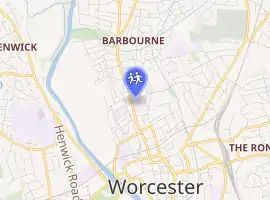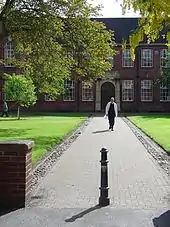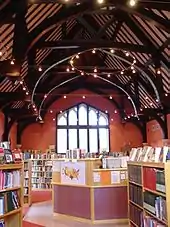Royal Grammar School Worcester
The Royal Grammar School Worcester (also known as RGS Worcester or RGSW) is a eleven-eighteen mixed, independent day school and sixth form in Worcester, Worcestershire, England. Founded before 1291, it is one of the oldest British independent day schools.
| Royal Grammar School Worcester | |
|---|---|
 | |
| Address | |

| |
Upper Tything , , WR1 1HP England | |
| Coordinates | 52.2004°N 2.2242°W |
| Information | |
| Other names |
|
| Type | Independent day school |
| Motto | Latin: Respice et Prospice (Remember the Past and Look to the Future) |
| Established | 1291 |
| Founder | Bishop Bosel |
| Local authority | Worcestershire County Council |
| Department for Education URN | 117038 Tables |
| Headmaster | John Pitt[1] |
| Gender | Mixed |
| Age range | 11–18 |
| Enrolment | 1,272 (Across all of the family of schools in 2019)[2] |
| Capacity | 2,182[2] |
| Houses |
|
| Colour(s) | Green, blue, white |
| Alumni | Old Elizabethans |
| Website | www |
In September 2007, the school merged with the neighbouring Alice Ottley School and was briefly known as RGS Worcester and the Alice Ottley School (RGSAO) before reverting to their original name. The school began accepting girls in 2003, prior to the merger. The school currently consists of the main high school and three preparatory campuses known as RGS Springfield (previously of Alice Ottley School)[3] RGS The Grange (opened 1996).[4] and RGS Dodderhill.
Until 1992 it accepted boarders. Boarding pupils would reside in Whiteladies House, a building that is rumoured to contain hidden treasure from Charles I from when he sought refuge there during the Civil War.[5] It is now a day school.
Tracing its origins back to the 7th century, it is the sixth oldest school in the world.
History
The school was founded as a secular monastic school in Worcester in around 685 by Bishop Bosel.[6] This makes it the 6th oldest school in the world. It was located outside the monastic precincts (as with the King's School, Canterbury) and catered for the relatives of monks and children intending to go into the monastery. The first written reference to the school appears in 1265 when the Bishop of Worcester, Walter de Cantilupe, sent four chaplains into the city to teach.[7]
Conclusive evidence appears in 1291 when an argument was settled by Bishop Godfrey Giffard regarding who owned the wax from the candles used at the feast of St Swithun. It was decided that the scholars of the Worcester School owned it, and the Rector of Saint Nicholas Church had to rely on the generosity of the scholars in order to get candle wax. The headmaster is mentioned as Stephen of London. The letter dated December 1291 is in the County Records Office in Worcester.
The next headmaster was appointed in 1312 as Hugh of Northampton as recorded in the Bishop's register for that year. He was appointed personally by the Bishop of Worcester, Archbishop of Canterbury, Lord Chancellor Walter Reynolds. The school continued to exist under the control of the city guilds through the centuries with various records of headmasters being appointed, again listed in the registers of the bishops of Worcester. One in particular was 'Sir Richard (Chaplain)', who was dismissed by the bishop of Worcester, Philip Morgan, in 1422 for taking money from the scholars for his own use. He was replaced the same year by Sir John Bredel. Sir Richard Pynnington was appointed in 1485 and is known to have given money to the Archbishop of Canterbury's fund, showing the strong connection of the school with the church.
Rival schools
In 1501 an attempt was made at establishing a rival school in the city, but the Bishop of Worcester at the time, Silvestro de' Gigli, passed a law that stated any person who set up a school in the city or monastic precincts would be excommunicated. Thus all rivals ceased to exist, and the headmaster of that said school, Hugh Cratford MA, was created headmaster of the City School in 1504.[8]
In 1541, however, Henry VIII founded a new school in Worcester;[9] The King's School Worcester became a rival school, with the rivalry manifesting itself in sports fixtures between the two schools. The rivalry continues to this day. The sporting fixtures regularly attract thousands of spectators.
Royal charters
After a petition by some notable citizens of Worcester to endow the school permanently, the school was given a Royal Charter by Queen Elizabeth I in 1561 and a governing body known as the Six Masters was set up, which remains as the governing body of the new RGS Worcester school today. Amongst famous Six masters are John Wall, Earl Beauchamp, Charles William Dyson Perrins and Anthony Lechemere.[7]
The Six Masters acquired much land for the school including its current site bought in 1562, the Pitchcroft fields, now used as the city racecourse, and land in Herefordshire still owned by the school. The 1906 Charity Commission survey also recorded a number of Pubs in Worcester which still exist today.[5]
A second Royal Charter was granted in 1843 by Queen Victoria, and the title of 'Royal' was conferred in 1869.[10]
Houses
The house system was introduced in 1899 by the then headmaster Frederick Arthur Hillard. Initially six houses were established, and membership of houses was based on the place of residence of each boy. The original houses were: Boarders, Barbourne, City, St. John's, County A, and County B. In 1909 the house system was changed to reflect the increasing number of boys in the school, and the difficulty of allocating pupils on the basis of where they lived. The six houses created in 1909 were: School House, for boarders, (which, due to common usage, changed to Whiteladies, as this was the building in which the boarders lived); Temple (after Henry Temple, headmaster 1850s); Tudor (after Elizabeth I); Woolfe (after Richard Woolfe, benefactor 1877 ); Wylde (after Thomas Wylde, benefactor 1558); and Yewle (after Robert Yewle, Six Master 1561). In 1963 two additional houses were created by the then headmaster Godfrey Brown, namely Langley (after William Langley, Six Master 1561) and Moore (after John Moore, benefactor 1626).[5]
In 2013/ 2014, the house system changed from six houses (Flagge-red for Flagge Meadow, Butler-Yellow for the old Butler Library, Cobham- gold for Cobham Hall, Eld- Green for Eld Hall, Perrins- orange for Perrins Hall and Britannia-blue for Britannia house) to the current house system.
The current houses are:
| House | Colour |
|---|---|
| Whiteladies | |
| Elgar | |
| Ottley | |
| Wylde |
The school holds a yearly house championship, decided by a range of events throughout the school year in which all six houses compete, with the winners of each event being awarded eight points, the second placed house seven, down to the losing house one point. The house championship was traditionally called the 'Cock House' (or Cock House Cup Competition[5]) competition, its name deriving from that of the Cock. The original cup that was competed for is one which was presented to the school in 1902 by the Old Elizabethans' Association; in modern times competition is for a cup which was introduced in 1978.[5]
Connections
The school is a member of the 'Monmouth Group', a collection of schools similar in aims and membership to that of the Eton Group. The school is also a member of the HMC.
As of 2019, the school is officially partnered with Dodderhill Independent Girls School, now known as RGS Dodderhill.[11]
Land and buildings
Many of the current buildings were paid for Charles William Dyson Perrins, who was an Old Boy and a member of the school's governing body. Perrins Hall was named after his father James Dyson Perrins, owner of Lea and Perrins Worcestershire Sauce, who went to the school.
The basement of Perrins Hall contains a rifle range, which was added in 1914.[5] The back rooms of Perrins Hall used to be the sixth form common rooms and are now used for storage.
Flagge Meadow
Flagge Meadow is located nearby at the back of the school, next to the Worcester and Birmingham Canal. Flagge Meadow (pronounced Flag) was first levelled and used for cricket in 1886.[5] The first recorded match to be held there was in 1939, when the school played Merton College, Oxford.[12] The ground has also played host to several Second XI fixtures for the Worcestershire Second XI in the Second XI Championship and Second XI Trophy.[13][14] In 2007, the ground held a single List-A match for Worcestershire when they played Sri Lanka A.[15] Each year in the summer term cricket is played at Flagge Meadow.
School's halls

The Old School buildings were built in 1868 on a site owned by the school since 1562.[5] The Main Hall, Eld Hall and adjoining buildings were designed by A E Perkins in the Gothic style. It is three bays long with a central lantern. A life-size statue of Elizabeth I by R L Boulton stands above the central window.[16]
The Perrins Hall was built in 1914 to the plans of Alfred Hill Parker (an Old Boy) in a Jacobethan style with an Oriel Window on the staircase end and balcony looking over the hall. The interior is panelled with fitted bookcases (which make up the Dowty Library[5]) and a plastered ceiling. Two war memorials for the two World Wars are housed in the hall and a life-size portrait of Charles William Dyson Perrins hangs opposite the fireplace. Portraits of the 20th-century headmasters hang below. The school organ is in this building, and is played regularly at assemblies.
The Clock Block is connected to the Perrins Hall and was built in 1927, and had extension work carried out in 1967 to link it to the Science Block. It has a bell tower and clock above the entrance. The clock is made of Cotswold Limestone, and is surmounted by the carved head of Old Father Time.[5] To commemorate the millennium a stained glass window was commissioned and installed over the main entrance to the Clock Block. In the Alice Ottley Building, formerly the main school building for the Alice Ottley School, there are two more halls: Cobham Hall and Main Hall. Main Hall is the school's dining hall, with views over a lawn and a stained glass window commemorating Miss Margaret Spurling, headmistress of the Alice Ottley School from 1912 to 1934.
Other buildings

The science buildings were built in 1922 and opened by the Duke and Duchess of York (later King George VI and Queen Elizabeth).[5] The science buildings were subsequently refurbished in 1996 and thereafter re-opened by Michael Portillo. The science block features at one end of a long path which comes from the main quad of the school, which is the location of Perrins Hall and the Main block. This long path is known as Long Walk.
Whiteladies House, built in the 17th century, was traditionally the Headmaster's house and stands opposite Clock Block across the gardens. This is currently where the school admin staff, nurse and school heads of departments are situated. The West wall was part of the Whiteladies Priory chapel built in 1255.[8] Its name derives from the white habit that is worn by Cistercian nuns, who were based at a Nunnery, which was adjacent to Whiteladies.[5]

Other buildings include Priory House (17th Century), Pullinger House (1980s), Gordon House (after Adam Lindsay Gordon OE), Stephen Hall (1961, opened by Queen Elizabeth the Queen Mother on her second visit to the school) and the Design Centre comprising various engineering facilities.[5]
The most recent building work to a school building took place on the school's Performing Arts Centre. The Performing Arts Centre (formerly a gymasium), was extended to create three spaces: Studio 1 downstairs, Studio 2 upstairs, and the Godfrey Brown Theatre. An entrance was added to the back of the building and a car park was opened. This project cost the school £2.8 million.
The school's library was refurbished in 2001, and was renamed the Philip Sawyer Library (after the former Chairman of the Governors). It was opened by the then Poet Laureate Andrew Motion. The library is situated above Eld Hall, and features a high vaulted roof structure.
Sport
Rowing
The school has a rowing club, the Royal Grammar School Worcester Boat Club, which is based on the River Severn. The club is affiliated to British Rowing (boat code WRG)[17] and has produced British champion crews at the British Rowing Championships in 1997, 2000, 2001, 2002 and 2003.[18][19][20][21][22]
Other Sports
The school offers Rugby union and football to boys and hockey, netball and rounders to girls. The school stopped teaching lacrosse in 2010.
Both boys and girls are taught tennis, athletics, swimming and, after a six-year campaign by a former pupil, cricket is now taught to girls as well as boys.
Notable patrons
- Bishop Godfrey Giffard (1240–1306) Bishop of Worcester and Lord Chancellor of England.
- Bishop Walter Reynolds (d.1327) Archbishop of Canterbury and Lord Chancellor of England.
- Hugh Latimer (1470–1555) Bishop of Worcester and Protestant Martyr.
- C.W. Dyson Perrins Chairman Royal Worcester Porcelain and collector.
- Queen Elizabeth I
- Queen Victoria
- Godfrey Brown Headmaster 1950–78,Olympic Gold Medallist.
Notable alumni
Famous Old Boys of the school or Worcester Old Elizabethans (more complete list here), include (in alphabetical order)
- John Mark Ainsley (born 1963) Tenor
- Sir Roy Allen (R.G.D. Allen) (1906–1983) Economist
- Jonny Arr (born 1988), rugby union player[23]
- John Billingham (1930–2013) Former director of the SETI Program Office and Director of the Life Sciences Division at the NASA Ames Research Center
- Dom Augustine Bradshaw (1574–1618) Catholic missionary
- Sir Reginald Bray KG (d.1503) Statesman and Architect
- Tim Curtis (born 1960) Cricketer, former captain of Worcestershire.
- Tom Dyckhoff (born 1971) Architecture critic and TV Presenter
- John Francis Lane (1928–2018) Actor, journalist and critic
- Adam Lindsay Gordon (1833–1870) National Poet of Australia
- Dean Headley (born 1970) Former England International Cricketer
- Imran Khan (born 1952), 22nd Prime Minister of Pakistan, politician, cricketer and philanthropist
- John McKenna (born 1964), Royal Society of British Sculptors
- William Langland (1330–1387)
- Benjamin Williams Leader RA (1831–1923) Artist
- Sir Thomas Littleton (1407–1481) Lawyer
- Jurek Martin (born 1942) Financial Times Foreign Correspondent and former Foreign Editor
- Liam O'Driscoll (born 1987), cricketer
- Neil Pinner (born 1990), cricketer
- Graham Robb (born 1958) Author
- T J Cobden Sanderson (1840–1922) Arts and Crafts movement pioneer
- Philip Serrell TV Auctioneer.
- Ollie Steele (born 1993), cricketer
- John Trapp (born 1601) English Anglican Bible commentator
- Ben Warren (born 1879) Footballer for England
- Professor Michael Wilding (born 1942) Australian Author
- Sir Edward Leader Williams (1828–1910) civil engineer (Manchester Ship Canal)
References
- "Headmaster's Welcome". Royal Grammar School Worcester. Retrieved 8 February 2019.
- "Royal Grammar School Worcester". Get information about schools. GOV.UK. Retrieved 8 February 2019.
- RGS Springfield – History
- RGS The Grange – History
- Wheeler, A R. Royal Grammar School Worcester, 1950 to 1991 with retrospect to 1291, Royal Grammar School Worcester, 1991. ISBN 0-9516775-0-0
- "History". RGS Worcester. 2017. Retrieved 30 December 2017.
- Follet, F. V. History of the Worcester Royal Grammar School, Ebenezer Bayliss, Trinity Press, 1950.
- Leach, A. F. Schools of Mediaeval England,Methuen Young Books, 1969. ISBN 0-416-13360-6.
- Craze, M. King's School, Worcester: 1541–1971., Ebenezer Baylis and Son, 1972
- Leach, A. F. Victoria County Histories: Worcestershire Vol IV- Schools, 1914.
- "Dodderhill – RGS – The benefits of our new partnership with RGS Worcester". project-future.co.uk. Retrieved 26 September 2019.
- Other matches played on Flagge Meadow
- Second XI Championship Matches played on Flagge Meadow
- Second XI Trophy Matches played on Flagge Meadow
- List-A Matches played on Flagge Meadow
- Pevsner, N. Buildings of England: Worcestershire, Yale University Press, 2002. ISBN 0-300-09660-7.
- "Club details". British Rowing.
- "Full archive of results". Web Archive.
- "National Championships". Times Digital Archives.
- ""The Daily results service." Times, 23 July 2001, p. 10". Times Digital Archives.
- ""The results service." Times, 22 July 2002, p. 26". Times Digital Archives.
- ""Today's fixtures." Times, 21 July 2003, p. 32". Times Digital Archives.
- "Arr signs on at Sixways". Worcester News. 19 January 2012. Retrieved 14 February 2012.
External links
| Wikimedia Commons has media related to Royal Grammar School Worcester. |